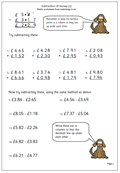 This is another in our series of worksheets covering the four rules. Children should be competent with the standard written method of subtraction before moving onto subtracting decimals. Money is an excellent way to show how decimals work and it is important to ensure that there are two numbers after the decimal point. Another key point, of course, is to make sure the columns are correctly in line and that a decimal point is included in the answer. Make sure that questions 9 to 15 are written out in the correct format: vertically rather than horizontally.
This is another in our series of worksheets covering the four rules. Children should be competent with the standard written method of subtraction before moving onto subtracting decimals. Money is an excellent way to show how decimals work and it is important to ensure that there are two numbers after the decimal point. Another key point, of course, is to make sure the columns are correctly in line and that a decimal point is included in the answer. Make sure that questions 9 to 15 are written out in the correct format: vertically rather than horizontally.
Tag: subtraction
Maths Worksheet: Year 4 Find a Difference
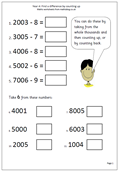 Sometimes a simple question can reveal a great deal about how children deal with numbers. This maths worksheet on finding differences is full of such questions.
Sometimes a simple question can reveal a great deal about how children deal with numbers. This maths worksheet on finding differences is full of such questions.
Let’s look at 3005 – 8 which is easier to do mentally than on paper.
There are several ways that this can be done.
1. Count down, one at a time, 8 from 3005, saying each number as you go. Fingers may be held up on each count down until 8 is reached.
3004, (1), 3003 (2), 3002 (3), 3001 (4), 3000 (5), 2999 (6), 2998 (7), 2997 (8)
2. A different way is to take the 8 from 3000, then add 5.
3000 – 8 = 2992
2992 + 5 = 2997
3. A third way is to take 5 off the 8 leaving 3.
Then take 3 off 3000 = 2997
It is well worth talking to children about how they do this kind of question and what strategies they employ. Much will depend on their knowledge of number.
Maths Worksheet: Subtract a Single Digit (year 2)
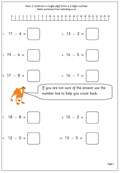 Once children are confident with subtracting single digits from single digits they can move on to subtracting from 2-digit numbers. This maths worksheet has a number line to help. Children can either start with the larger number and count back, or start with the smaller number and count on.
Once children are confident with subtracting single digits from single digits they can move on to subtracting from 2-digit numbers. This maths worksheet has a number line to help. Children can either start with the larger number and count back, or start with the smaller number and count on.
The next stage would be to start with the smaller number and know how many it takes to reach ten and then add on from there. E.g. 13 – 8. Start at 8 and know that add 2 will make ten. Continue from ten and add on the unit digit, in this case 3, to make 2 + 3 = 5. 13 – 8 = 5. A combination of knowing and counting on may well take place: many adults use this technique.
Maths worksheet: Standard subtraction of 3-digits
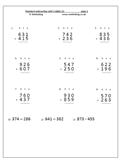 Here is a basic set of subtraction questions using 3-digit numbers. They should be tackled in the standard method as described in earlier 2-digit subtraction worksheets. Notice that there are no zeros in the tens column as this can lead to particular problems and needs a set of questions all of its own.
Here is a basic set of subtraction questions using 3-digit numbers. They should be tackled in the standard method as described in earlier 2-digit subtraction worksheets. Notice that there are no zeros in the tens column as this can lead to particular problems and needs a set of questions all of its own.
The last three questions have been set out in a horizontal form. To answer them they should be rewritten in the standard way. Look out for mistakes where decomposition was needed but where the subtraction has been reversed eg 3 – 7 has been done as 7 – 3.
If these questions are answered correctly and in the correct method then it can be said that mastery of the subtraction method is well on its way!
Mental arithmetic: Subtracting single digits from multiples of 100 and 1000
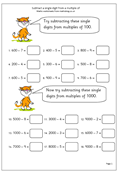 A pretty straightforward worksheet in two parts. The first part looks at subtraction of a single digit from multiples of 100. The second half looks at subtracting from multiples of 1000. The obvious way to do this is to count back, but when you ask children who are very quick with maths they seem to employ other tactics with little to do with subtraction. For example, one 9 year old boy told me his explanation of 8000 – 6:
A pretty straightforward worksheet in two parts. The first part looks at subtraction of a single digit from multiples of 100. The second half looks at subtracting from multiples of 1000. The obvious way to do this is to count back, but when you ask children who are very quick with maths they seem to employ other tactics with little to do with subtraction. For example, one 9 year old boy told me his explanation of 8000 – 6:
‘turn the 800 into 799 and add 4 to make the next whole ten. Answer 7994’
Not the clearest explanation ever, but it seems that he is doing a kind of decomposition in his head – interesting!
Standard written subtraction with zeros.
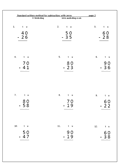 Here is another maths worksheet which looks at the standard method of subtraction, often called decomposition. Once again the numbers are small, and many children will be able to work the answers out ‘in their heads’. However, it provides good practice with the method, whilst not having to worry too much about the size of the numbers involved.
Here is another maths worksheet which looks at the standard method of subtraction, often called decomposition. Once again the numbers are small, and many children will be able to work the answers out ‘in their heads’. However, it provides good practice with the method, whilst not having to worry too much about the size of the numbers involved.
All these subtraction questions have a zero in the number which is being taken from. This can sometimes cause children a few problems: watch out for the mistake of saying ‘0 – 8 is 8’.
Once these have been mastered it is only a short step to being able to successfully complete any subtraction sum.
Mental arithmetic: subtracting from 100
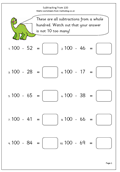 Here is a maths worksheet on using mental arithmetic to subtract from 100. This is probably the type of calculation we do more than any other, especially when working out change from £1.00. There are several processes or ways to do these.
Here is a maths worksheet on using mental arithmetic to subtract from 100. This is probably the type of calculation we do more than any other, especially when working out change from £1.00. There are several processes or ways to do these.
Let’s look at an example: 100 – 47.
One way is to add on 3 to make 50 then 50 to make 100: add the 50 and the 3 to make 53.
Another way is to add 50 to make 97 then count on 3 to make 100.
Watch out for the very common error that children make which is adding 3 to the 7 and adding 60 to the 40 and coming up with the answer 64!
Maths worksheet: subtract from 20 mentally
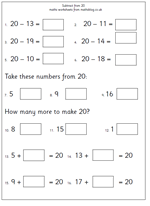 There are a number of different ways in which subtraction problems can be phrased including terms such as ‘Take from’ and ‘How many more’. This maths worksheet looks at some of them, whilst concentrating on subtracting from 20 using mental methods.
There are a number of different ways in which subtraction problems can be phrased including terms such as ‘Take from’ and ‘How many more’. This maths worksheet looks at some of them, whilst concentrating on subtracting from 20 using mental methods.
The usual method of mentally subtracting is to ‘add on’. For example 20 – 7.
Add 3 to 7 to make 10 and then add a further 10 to make 20. Answer 3 + 10 which is 13.
Or, the ten could be added first to make 17 and then count on to 20.
Either way is equally good.